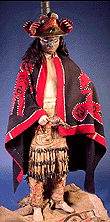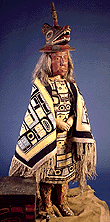
Clothing of Tsimshian Nobles
 |
Tsimshian society was divided into three classes: nobles, commoners and slaves. Wealth was reflected in the clothing and personal adornments worn by the chiefs, their wives and children. Nobles wore elaborate headdresses and helmets with crest images carved or painted on them. Their ceremonial clothing included woven Chilkat blankets, aprons and leggings. Following the introduction of European woollen cloth, a new type of clothing was made from dark blue trade blankets, decorated with red flannel crest designs and pearl buttons. This mannequin of a chief is wearing a wool button blanket over his shoulders, a leather shirt, a painted leather apron with deer hoofs attached to the fringes, and leggings. He is holding a Raven rattle. On his head is a headdress depicting Nagunaks, the keeper of souls in the underworld; his face has the features of Bear and his red hands may reflect the fact that he held the souls of the dead until they were ready to be reincarnated in humans. The chief's black mask with taunting white eyes was part of a ceremonial dance costume. |
 |
Everyone wore personal adornments, although what people could wear was regulated by daily activity and social rank. Chiefs and their wives and children wore bracelets, labrets (lip plugs), earrings, pendants, and elaborately decorated clothing, as symbols of spiritual power and prestige. This mannequin depicts a noble woman wearing a Wolf helmet, a Chilkat blanket and tunic, and a labret in her lower lip. |
